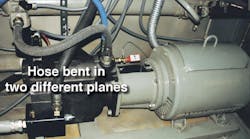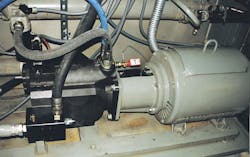What's Wrong With This Picture?
At first glance, this looks like almost every pump installed on a power unit. On closer inspection, however, the hose routing violates design recommendations published by Parker Hannifin and every other major hydraulic hose manufacturer in the U.S.
Another problem with the hose routing in the photo is the disarray of hose placement and positioning. It appears that little or no forethought was given to hose routing. It looks as if some of the hoses can rub against surrounding equipment and each other. Eventually, hose flexure from continued cycling will abrade away the hose cover. Once this happens, leakage can start — and increase over time.
Notice the hose coming off the top of the pump and connected to the filter. It is bent in two planes. Most hose-specification literature recommends that hose not be bent in more than one plane. Doing so can cause uneven distribution of tension to reinforcing wires within the hose. As pressure pulsations occur in the hydraulic system, the overloaded strands undergo excessive tensile stress. After continuous cycling, the over-stressed strands can fail due to fatigue and eventually cause the hose to rupture. Worse yet, the failure can be catastrophic in nature, providing little or no warning of the impending failure.
Some designers may contend that there often is no way to avoid bending a hose in two planes because of the location of components. In such cases, a straight length of hose between the bends can act as a transition zone that allows the support wires to relax — but only if the straight section of hose is supported by a hose clamp.
A less-preferred alternative is to divide the hose into two separate assemblies by installing a fitting in the middle of the straight section and supporting the fitting with a stationary bulkhead plate. This technique is less preferred because the two hose assemblies and fitting increase cost and introduce potential points of leakage. The hose in the photograph has a straight section between the two bends, but clearly it is not supported by a clamp or bulkhead. Unless maximum pressure is much lower than the hose's pressure rating, the hose eventually will rupture. (If system pressure is much lower than the hose's rating, then someone paid too much by specifying a higher-pressure hose that was unnecessary.)
An even simpler solution: install a 45° fitting on the pump port. The fitting would provide bending in one plane, so the hose would have to bend in only one plane. Obviously, fewer bends improve flow. In addition, the 45 fitting would have reduced the length of hose needed for assembly.
To avoid the routing confusion, the designer should have evaluated every hose assembly required and worked out a routing plan to make a neater assembly — before the first hose had been installed. If possible, hoses should be aligned parallel to each other, then clamped in place so they cannot rub.
Practicing good hose routing not only makes for a neat, clean system, but improves equipment reliability by preventing abrasive wear. It also makes maintenance easier because technicians will not have to work around a rat's nest of hoses or disconnect hoses to gain access to other components.
Ron Mramor is Technical Services Engineer at Parker Hannifin's Hose Products Division. For more information, visit www.parker.com/hpd.


